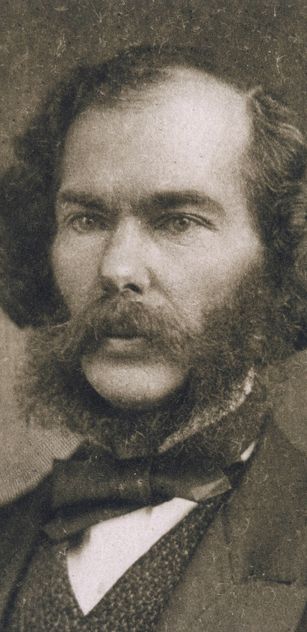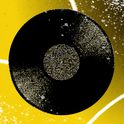When the Scottish phrenologist George Combe was sent a cast of 25-year-old Mary Ann Evans’s head in 1844, he took it for a man’s. “Miss Evans’s head is a very large one, 22 ¼ inches round,” he wrote; “the intellect predominates,” while the “Animal” and “Moral” regions are roughly equal, with “the moral being quite sufficient to keep the animal in order”. “She has a very large brain,” he affirmed eight years later, when he finally met her.
Mary Ann Evans was never admired for her looks. To add to her outsized head, she had a long face, large nose, crooked teeth and jutting lower jaw, which she self-consciously hid with her hand in the most widely available photograph of her, taken in the 1850s. It was a face unsuited to be framed with simpering curls.
Several of her contemporaries judged her looks “manly”, though it’s tempting to read into their pronouncements the influence of all she achieved as George Eliot. No woman of English letters was more famous, prosperous or successful, while few were more disinclined to observe traditional female niceties.
Mary Ann was her own person almost from the start: precocious, bookish, a brilliant student whose essays her English teacher in Nuneaton took home to savour, and whose superiority cowed her classmates. Later, she kept up an intense correspondence with one of her teachers, Maria Lewis—her tone mannered, as if trying on a maturity she didn’t yet possess. Her intellect was always running ahead of her, ahead of both her years and her station. Mary Ann possessed a surfeit of ego and a surfeit of insecurity with it. Losing her mother at 16 and her beloved father before she turned 30, she lacked familial support, yet burned with ambition. It was, she confided to Lewis, her “besetting sin”.
Chief among these ambitions was a desire to be noble—as true to her principles and beliefs as her idealised heroine in Middlemarch, Dorothea Brooke. Exposed to deist literature through the progressivist circle around Charles Bray, the Coventry-based ribbon-maker and social reformer, she rejected supernatural religion once and for all, straining relations with her father. Though she continued to accompany him to church, she absented herself “by dint of making myself deaf and looking up at the roof and arches”. As Rebecca Mead notes in The Road to Middlemarch: “She would be there but not there.”
Mary Ann embarked on a translation of David Friedrich Strauss’s 1,500-page rationalist doorstopper, The Life of Jesus, Critically Examined (1835). Over the better part of two years, this gargantuan undertaking distressed and exhausted her; she began to suffer the headaches that would blight her writing life, as well as the anguished self-doubt that simple faith might have obviated. But if her own faith could not withstand the assault of reason, still she needed some higher god. And if she could not be true to Christianity, then she would be true to philosophy and art and love.
Clare Carlisle’s principal achievement in The Marriage Question—a richly textured and absorbing biographical study—is to reveal how, over the course of her novels, essays and poetry, George Eliot systematically built a secular philosophy that concerned itself with morality. She tasked the human soul with the same rigorous self-examination and accountability that any great religion might demand of its adherents. How to be a good person without the scaffold of Christianity became the intellectual and emotional quest of her mature years.
The problem was that—even as she glimpsed this noble path ahead—Mary Ann hobbled herself by eloping with George Henry Lewes, a married man and a father of three with a free-loving past behind him. A fallen woman—who was she to speak of morality?
The ready answer is that she didn’t. George Eliot did the speaking for her.
As with any marriage, Mary Ann’s relationship with Lewes, though never officially consecrated and therefore, technically, not a “marriage”, possessed both a public aspect and a private one. Publicly, it was a scandal. To her fury, Mary Ann (now styling herself Marian Evans or, more pointedly, “Mrs Lewes”) became a social outcast. Polite society gossiped about her, refusing to invite her to dinners, holiday festivities and other gatherings. Her siblings abandoned her, too, sacrificing her on the altar of a pinched lower-middle-class righteousness. For his part, George Combe recanted his high opinion of her phrenological assets, writing in his journal that his previous assessment had been “written from eye-observation. She has gone off as the mistress of Mr. Lewes”.
On the inside of the couple’s life, if Eliot is to be taken at face value, it was all sunshine and pure gold. But, of course, things had to be sunshiny, because in choosing Lewes, a man some dismissed as loud and self-regarding, Marian Evans had forfeited almost everything else.
As opposed to her inward and passionate nature, Lewes was all outbound energy: gregarious to a fault, fickle, brilliant, always in motion. He could sweep a room in minutes, talking to everyone and amusing them too. She stayed in the corner. An intimate tête-à-tête was more her style; though she reputedly had the most beautiful voice, it was mostly heard in a whisper. What the couple shared was an insatiable curiosity, a hunger for knowledge and a passion for life. A polyglot, Marian stuffed her notebooks with entries on The Canterbury Tales, Hindu literature, German philosophy, Machiavelli, Jewish mysticism. In the margins, she practised her Hebrew letters, a script she studied over many years.
* * *
Such was her “double life”—the term Marian gave to her shared existence with Lewes, which Carlisle interrogates here in the service of exploring what she calls “the marriage question”, which pertains to everything women stand to gain or lose, in both life and art, when tying themselves to another. Marian’s inspiration for her double life was Baruch Spinoza, whose Ethics she began translating on her “honeymoon” in Berlin in 1854: from Spinoza, according to Carlisle, “She learned that if two like-minded people, sharing ‘the same nature’ live together, they will become ‘a double individual more powerful than the single’.” This reads like a tuppenny truism today, fit for an astrology column not the annals of philosophy. But it was radical at the time because it sidestepped the pieties of marriage.
Although the £75 that Lewes secured for Marian’s translation eventually came to naught, the experience set up a dynamic that would shape their long years together: she wrote, while he negotiated ever higher fees that went straight into his bank account.
Money matters aside, modern feminists will delight in the reversal of gender roles in the Leweses’ marital arrangements as she blossomed into George Eliot, earning far more than he did. Lewes supported her, believed in her “vocation”, bolstered her through crippling depressions, shielded her from critics, read her work and acted as her literary agent, guarding her privacy and public appearances. Her writing time was fiercely protected. Each day, she retired to her study after breakfast and worked from 8am for five hours. Domestic staff were instructed by Lewes not to bother her: she’d show up for supper like a hotel guest, never knowing what would be served.
But the “marriage” was also companionable. The lovers took afternoon walks, read together and discussed fiction, philosophy and science—the latter both subjects Lewes wrote on avidly. Still, it was “the marriage question” that preoccupied Eliot in her own work. She may not have respectability, but she could, in novel upon novel in which legal marriages were rarely preferable to unions such as her own, skewer the tight-lipped and superficial morality that cast her out of society. Those marriages entrapped women, holding them hostage to fortune (Gwendolen and Grandcourt in Daniel Deronda) or victim to violence (Janet in Scenes of Clerical Life). They could bind people together in mutual unhappiness (Lydgate and Rosamond in Middlemarch), even if misery might be a gateway to martyrdom (Dorothea Brooke). In fiction, Eliot exercised her Spinozan commitments to the extreme, testing the double life’s ability to achieve balance, authenticity and fulfilment.
The marriage question was the obsession du jour: Eliot had read all of Austen and the Brontës before she began writing fiction, but marriage as a happy ending was not her style—or, certainly, not enough. Rather, she interrogated marriage as a psychologist might interrogate the mind, looking for deeper urges and unspoken bargains.
Carlisle moves from novel to novel, subjecting them to the exacting lens of philosophy. Her chapter on Middlemarch—the masterpiece of Eliot’s middle life—is a dazzler, a thorough-going dialectical affair, as indebted to Hegel (Marian’s new philosophical idol) as Eliot was herself in her preoccupation with reconciling thought and feeling or to find a happiness that transcended “personal attachment”.
Middlemarch turns the marriage question inside out by starting rather than ending with marriage, and a wrong-headed one at that. If the novel had been in Jane Austen’s hands, quips Rebecca Mead, “the courtship of the blossoming Dorothea by the dry-as-dust Casaubon would have been a comedy”. Whereas for Eliot the mismatch is deadly serious. Dorothea sought in the “double life” nothing less than an ennoblement of the soul, only to find that Casaubon was merely correct, not wise: a plodding intellect, not an inspired one. Her marriage became one she had to survive. In mirror fashion, Eliot has Lydgate make the same error in choosing for a soulmate a woman who possesses every virtue (beauty, accomplishment, a desire to serve others) except the requisite depth.
Dorothea could have married the “amiable baronet” Sir James Chettam, says Carlisle. Yet “something is lost on that steadier, more complacent path – a deeper inwardness; better self-understanding; a knowledge of pain”—even if that inner knowledge serves to show up the error of one’s ways, inviting the self-torture of dreaming of something better. As the plot of Middlemarch weaves through a series of what-ifs and what-might-have-beens, Eliot suggests that we all toy with an “imagined otherwise”. This is why the novel is replete with “negations and questions—its numerous ‘nots’ and ‘what ifs’—channel a flow of hidden desires,” allowing Eliot to reveal the nature of human consciousness.
She interrogated marriage as a psychologist might interrogate the mind, looking for deeper urges and unspoken bargains
For Hegel, negation was a driving force, not just of metaphysics, but of nature and knowledge; in every case, being is inseparable from non-being, “just as life is haunted by death”. Meanwhile, the new evolutionary theory served to highlight all those lifeforms that did not survive natural selection, that might have been. Carlisle argues that Eliot “wove this vibrant negativity into the very sentence structure of Middlemarch”. She asked us to consider everything that is not. And so readers are acquainted with her characters’ dreams and desires; regrets, whimsies and hopes—the whole Hegelian panoply of imagined possibilities that lent her realist novel a dimension that none of her novelist peers had tapped: “a fantasy-life”.
Carlisle makes a bold choice to begin this book not with its subject’s birth but with her “marriage”—the commencement of her shared life with Lewes. So we begin with society not family, the canvas as broad and as populated with “types” as an Eliot novel itself. Indeed, if there’s a (potential) flaw in The Marriage Question, it is that Carlisle often sounds just like Eliot, her sentences pierced with the probing intellect and feeling that characterises her subject’s oeuvre. (“Squandering her gifts in intensely literary letters to a Midlands governess clouded her heart with an anxiety she could not confess or explain.”)
Prospect columnist Julian Baggini once hailed Carlisle’s biography of Kierkegaard to be the most Kierkegaardian biography there is. So it is here: Carlisle’s intense, empathetic study reflects Eliot back to us, echoes her and rises up to meet her in order to give Eliot her philosophical due.
Also her feminist due, since modern admirers of Eliot wholeheartedly wish she might have had it all: the respectability she craved, the freedom, the adulation. Eliot herself was against suffrage. Arguably, the most feminist action she ever took came just a year before she died (Lewes preceded her) when she married John Cross—friend and devoted fan, 20 years her junior—and promptly took off for a honeymoon in Venice.
If she’d hoped for the respectability that eluded her through her years with Lewes, she was to be disappointed. The social world that rejected her then now tittered behind her back, mocking the age difference between the newlyweds. Perhaps Eliot’s ambition, that “besetting sin”, got the better of her in the end; her hankering after legacy possibly leading her into marriage; her hope of being buried at Westminster Abbey (as Dickens had been, in spite of his blatant adultery) firmly in her sights. It was a wish denied, even if Eliot—agnostic, unrepentant, individualist to the end—was, by most other measures, a national treasure.














